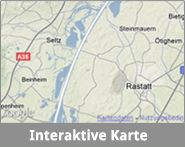Grasslands
Habitat types in grasslands according to the Habitats Directive
- “Dry and semi-dry calcareous grasslands” (Code 6210): You wouldn’t expect these habitats in floodplains, but in natural floodplains the river repeatedly pushes together high mounds of gravel which in former times had been settled by species of oligotrophic calcareous grasslands. Today these species have found compensatory habitats on the flood dykes. Such dry and semi-dry calcareous grasslands you can find at the flood dyke between Wintersdorf and Plittersdorf, along the lower Riedkanal and at the dyke of the river Murg. In spring you can pay attention to the blue grape hyacinth, also called baby’s breath, in early summer you can discover the military orchid, and in summer you can watch out for the bright pink of the carthusian pink and the tender quaking-grass. Further information
- “Oligotrophic meadows of the planar to submontane zone” (Code 6510) grow on intermediate sites, i.e. with a moderate level of wetness and nutrients. They are particularly species-rich if meadow sage also occurs, e g. east of Steinmauern, at the Altmurg, west of Ötigheim and near Bietigheim. If the great burnet occurs you might be able to observe the scarce large blue in July, when they lay their eggs into its flowers. Further information
- “Molinia meadows“ (Code 6410). In former times they were typical on sites with changing water levels in the Rhine valley due to the influences of the variable levels of the groundwater table of the Rhine valley. Originally their were only cultivated to produce litter, since the hard and dry hay wasn’t eaten by the livestock. After abandoning the use of litter more than 95 % of the molinia meadows in the upper Rhine valley have disappeared. Only five areas are left in the project area, with the sites at the Schafköpfel (Rastatt-Wintersdorf) and at the Teilergrund (Rastatt/Plittersdorf) being particularly species-rich. In summer the mouse-garlic with its pink flowers attracts particular attention, whilst in autumn the purple moor-grass is very beautiful. Further information
- "Alluvial meadows of river valleys" (Code 6440). This habitat types only occurs on one site, the “Spieß-Wiesen” south of Rastatt-Ottersdorf. The site is a complex of meadows also containing calcareous grasslands and oligotrophic meadows, and in its lowest section it developed an alluvial meadow with Cnidium dubium: a typical species for this habitat type is the critically endangered bog violet (Viola uliginosa). Further information
- “Hydrophilous tall herb fringe communities” (Code 6430) occur in the area mainly at fringes together with willow and alder along ditches and streams. Usually they are not under cultivation and only sometimes mowed. The stands can be very flowerful with different perennials such as wild angelica, willow herb, hemp-agrimony, meadowsweet or purple loosestrife. They a very important for the nourishment of a wide range of butterflies. Further information



